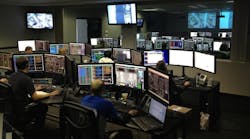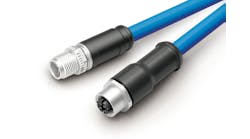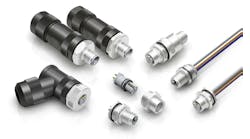Over the years that I have been writing for Control Design, the majority of my articles have focused on the deployment of automation. My view, from a guy in the trenches, is intentional as I would like to think that we are all in this together and sharing our experiences is for the good of all.
Deploying automation, however, is only half the story. Designing a control system, using the latest in technology, gives our machine or process a fresh breath of life, but what happens once the newness has worn off?
The general consensus would be that a new control system automatically provides a period of bliss where all the new components are happily doing their thing without intervention from maintenance. The more we build into the user interface of a system, the better we can identify what to do when the machine or process stops suddenly. If we plan it right, we will have some idea of what the machine was attempted to do when the unexpected stop happened, and hopefully we can use the various sensors in the process to tell us where the machine is in that sequence leading up to the failure.
While this might be enough to point us in the right direction as far as correcting the problem and resuming operation, wouldn’t it be better if we could predict that a failure was going to happen?
Any time a machine isn’t producing, personnel are tied up with trying to make it run again, and the company is losing money. For both the company and the maintenance team, a snapshot of the machine when the failure happened is of limited help. The sensor or actuator might be functional at the moment the snapshot happens but could degrade in operation immediately after the event.
The desire of all parties would be to have foreknowledge of the pending failure, with the benefit of being able to schedule maintenance during anticipated downtime to replace the component.
To put this into perspective, let’s say that one of your maintenance team members notices that a conveyor is starting to get louder. With the pressure of trying to keep production running, a decision might be to make note of the symptom and plan to replace the noisy bearing closer to its fail point. The problem with this approach is: how long do we have? Is the bearing about to fail? Is failure two months away? When it fails, will it only be the bearing, or will it cause other components to fail in a more catastrophic way?
In the above situation, solving that eventual failure might be as easy as swapping out the conveyor for one of the same size and performance, causing a minimum of downtime.
Imagine, however, if that was the bearing on the main air exchanger for the plant? Waiting until failure could cost thousands of dollars to repair, not to mention the loss in revenue if production on multiple lines has to stop while the repair is being made. The risky nature of this type of situation has prompted the emergence of an approach to predictive maintenance called remote condition monitoring.
In recent years, the Industrial Internet of Things (IIoT) has brought sensor input to mean more than just the off/on or analog feedback from a device. IIoT is an extension of IoT (Internet of Things), which basically describes a world where everything is connected to the Internet
Software applications can access data provided by all the devices that are connected and provide information to a service. A control system, if connected to a network, can provide a means by which third-party software can access the devices in that control system and gather data that can be evaluated to provide analytical reports on the true status of the devices.
Implementing such a high-tech solution might not be as complicated as one might think. You might be surprised to learn that many of the common sensors you use each day in your control solutions are actually capable of providing more than just the analog or digital signal that you use it for.
The connection methods are just the same as you are using them today, but, if connected to a specialty module, such as an IO-Link master, it can open up an extensive list of data that can be used by a remote monitoring system. Some of the data includes the make and model of the device; network or node assignment; and operating parameters such as temperature, voltage and current, as well as performance data.
Sure, your digital sensor might provide you with a 1 or 0 to tell you if it is ON or OFF, but it can also tell you, for example, how long it takes to produce a result once the sensor is tripped in normal operation.
The great thing about performance data is that it can be used as an indicator of pending failure. An inductive proximity switch, for example, might normally take 0.3 ms to turn on and 0.7 ms to turn off. If the surface of the proximity switch starts to accumulate ferrous material or a nonconductive film such as oil, the response times will likely alter. This might have a negative impact on your control system. The result might be not completely seating a component in an insertion application or the collision of two actuators that operate in close proximity to each other.
Other good examples of sensors that would be helpful in condition monitoring would be vibration and heat sensors on bearings, or strength of signal on IR or laser photo-sensors.
Condition monitoring, however, doesn’t have to involve an immediate leap into a cloud-based solution where third-party software takes all of the data from your networked devices, digests the data and gives it back to you in a report prompting you to do something.
It can start with add-on modules that have specific functions, for example, a blower monitoring module. These modules bring sensor data into a common location where a wireless or wired connection brings information to the attention of an interested party.
In this situation, the control system doesn’t have to be able to read smart devices. The add-on sensor module does the job of getting the data analyzed. The user can set limits of normal operation and the module will alert to function that exceeds the set limits.
For those that elect to build control systems using smart sensors and actuators, there is a serious consideration that will impact how you use the myriad information that will suddenly be at hand.
There is a lot involved in just making the process or machine operate using your control system. It can take hundreds of hours to design the system and then develop the software applications for your PAC/PLC and human-machine interface (HMI) to interact with the controls.
The investment in the hardware required to take advantage of the smart devices for condition monitoring is an important decision, but an even larger investment will be made in developing the software algorithm and analytics necessary to make use of the additional information shared from your devices. The decision to be made is whether to commit internal resources into this objective or hire an outside firm to take care of that for you.
Fortunately, the advance of IIoT has prompted some specialty companies to offer up such services, and, in many cases, they have pre-canned solutions to offer in this regard. While a customized solution might be most desired, a cost-effective solution that offers the end user the opportunity to take the pre-designed solution and identify the important sensors and processes to be flagged is an attractive possibility.
A great side benefit of publicly offered solutions using smart-sensor data analytics has prompted many hardware providers to get into the remote monitoring game themselves. The advantage of being able to make intelligent decisions about when to execute predictive maintenance, based on live data from your processes, is obvious to most companies, and the investment that these companies are willing to make in this regard is hard to ignore. This has created a competitive market, and the number of companies offering solutions is growing exponentially.
While the company I work for hasn’t embraced remote monitoring as yet, we have taken a major leap forward just a couple of years ago by investing in a cloud-based data collection system for our production output. With much less investment than I would have originally predicted, we were able to get a wired network into all of our production areas and install basic smart relays (mini-PLCs) on each line to collect the basic data of product produced and cases produced at the end of the line.
The cloud-based system then takes this data and, using our production schedule data, produces data that tells us how well we are running. With some add-on features, we are able to engage the line operators in some simple button presses on a tablet to tell us their observations on the line to support the overall equipment effectiveness (OEE) information that is reported by the cloud-application.
It has been an eye-opening experience for us and helped us realize that we don’t have to figure out a way to generate all these important decision-making tools in-house. Our hardware investment to get things going has already realized a significant return on investement (ROI) that we have turned back into additional applications on the base system to further enhance our performance.
The bottom line here is: don’t be afraid to investigate the potential of remote condition monitoring. It only takes one major equipment failure to make it readily apparent that being able to predict not just a future failure, but quantitative data to identify how soon that failure can be expected, is a very valuable tool in predictive-maintenance practices.
ALSO READ: Remove unplanned downtime digitally and securely
[sidebar id=1]





